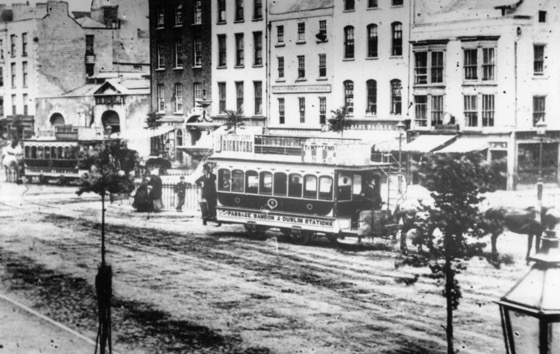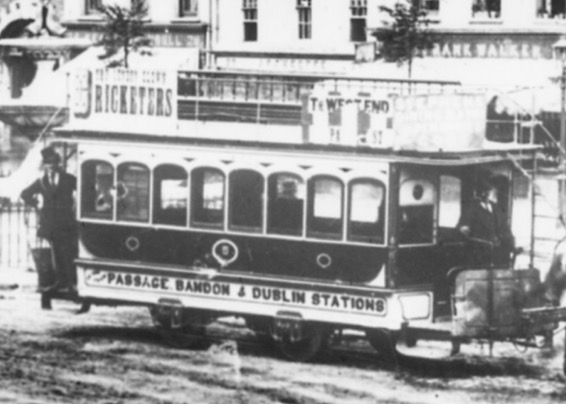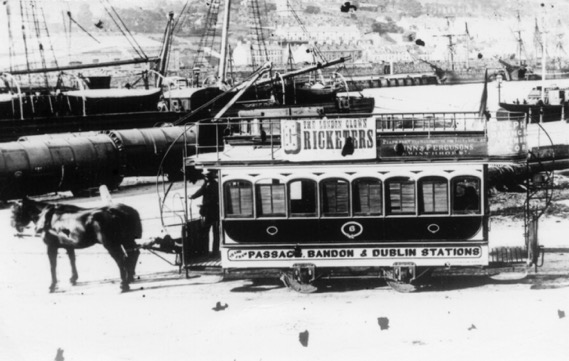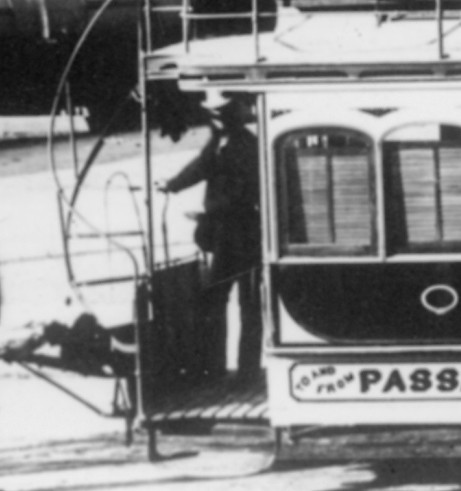Cork Horse Tramway
History
Although horse trams began operating in Cork at the relatively early date of 1872, they were to last a mere two years, the poor relationship between the owning company and the corporation being central to their demise.
The Cork Tramways Company, which was formed in 1871, was based in London, and though it had no local representation on its board, several of its directors also had interests in the railway companies that served Cork. The company apparently used 1860s tramways acts to obtain powers to build the tramway, seemingly without recourse to the local councillors, an approach that was to have serious consequences for the enterprise. Construction is thought to have commenced in 1871, the 5ft 3ins-gauge, horse-drawn tramway opening to the public on the 12th September 1872.
The system essentially comprised a single line with passing loops, connecting the railway stations in the south of the city with those in the north. The line commenced in the southeast of the city in Victoria Road near the terminus of the Cork, Passage and Blackrock Railway, then proceeded westwards along Albert Quay, passing the terminus of the Cork and Bandon Railway, whereupon it crossed the southern channel of the River Lee, navigated the centre of the city via South Mall, Grand Parade and Patrick Street, before crossing the north channel of the River Lee, whereupon it turned eastwards along King Street (now MacCurtain Street), passing the Great Southern and Western Railway's Summer Hill station, before reaching the terminus of the line opposite the GS&WR's main station on Alfred Street.
The southeastern terminus at Victoria Road was at some point extended eastwards along Navigation Wall to Marina; this took the line to its final size of 2.45 miles.
The line was not only expected to enable passengers to transit between the railway stations, but also allow the carriage of railway goods wagons; however, the latter business did not materialise and the circuitous route of the former meant that for those without luggage, it was not much slower to walk. The financial case for the tramway no doubt depended on servicing the needs of the more well-to-do citizens in the suburbs, to which end it unsuccessfully applied for permission to build extensions, all bar one of these being rejected by the corporation. As a result, the tramway always made a loss, on top of which it incurred yet more wrath from the corporation, which was greatly annoyed by the state of the tramway rails, which protruded from the road surface, causing great irritation to traffic.
By early 1875, the tramway was lying derelict, services probably having been withdrawn some time in 1874. Although the tramway was purchased by a local entrepreneur, who then founded a new company — the Cork Citizens Tramway Company — all efforts to reopen it were blocked by the corporation, the rails finally being lifted in 1876.
Uniforms
Despite its very short life — a maximum of two years, and possibly even less than that, given that the precise date that working ceased is unclear — several excellent photographs have survived. These clearly show that drivers and conductors wore smart, informal attire, comprising heavy-duty jackets, trousers, shirts and ties, and tall hats, the latter almost certainly being the favoured local fashion of the day. There is no evidence to suggest that badges or licences of any kind were worn.
Photographs of inspectors have not survived, and it is possible that the company never employed them.
Further reading
For a history of Cork's horse tramway, see: 'Tram Tracks Through Cork' by Walter McGrath; Tower Books (1981).
Images
Horse tram drivers and conductors
Horsecars No 5 (foreground) and No 6 (left background) pictured at the Berwick Fountain loop, Grand Parade in 1872, the year the concern opened. Photo courtesy of the Tramways and Light Railway Society, with thanks to David Voice.
An enlargement of the above photograph showing the driver (right) and conductor (on the rear platform), both of whom are wearing informal attire.
A pristine-looking Horsecar No 6, seemingly without a conductor, waits on Victoria Quay in 1872. Photo courtesy of the Tramways and Light Railway Society, with thanks to David Voice.
An enlargement of the above photograph showing the driver, who appears to be wearing informal attire and a tall hat.